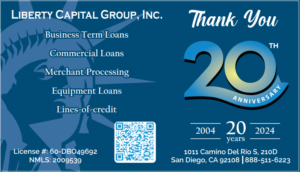Industry Guide to Equipment Financing For Your Industry.
Background of the Equipment Financing Industry
How big is equipment financing industry?
The equipment financing industry is a substantial sector within the financial services landscape, with an annual volume exceeding $1 trillion. This industry involves the leasing and financing of commercial equipment, which is crucial for businesses across various sectors to acquire the assets they need for operations and growth.
In 2024, the volume of new business in the equipment finance sector continues to show robust growth. For instance, in April 2024, the Equipment Leasing and Finance Association (ELFA) reported $11 billion in new business volume, marking a 17% year-over-year increase and an 18% increase from the previous month (ELFA Online). This growth trend is indicative of the sector’s resilience and its critical role in supporting business investment in equipment and software.
Overall, the U.S. businesses are forecasted to invest over $2 trillion in equipment and software in 2024, with more than half of this investment expected to be financed through leasing and other financial products (ELFA Online). This indicates a significant reliance on financing options to manage capital expenditures and operational efficiencies.
The ELFA also notes that approximately 80% of U.S. businesses utilize some form of leasing or financing to acquire equipment, underscoring the widespread adoption and importance of these financial products in the business landscape (ELFA Online).
Historical Development
The equipment financing industry provides businesses with the means to acquire essential equipment through various financing solutions, such as loans, leases, and lines of credit. This sector supports a wide range of industries, including manufacturing, construction, healthcare, agriculture, transportation, and technology.
Early Days:
- Pre-Industrial Revolution: Equipment financing was informal and often involved direct borrowing from wealthy individuals or local banks.
- Industrial Revolution: The rise of factories and mass production led to an increased need for heavy machinery, fostering the development of more formalized equipment financing options.
20th Century:
- Post-War Boom: After World War II, economic growth spurred demand for new equipment. Financial institutions and specialized finance companies began offering more structured equipment financing solutions.
- Technological Advances: The advent of computers and advanced machinery in the late 20th century necessitated significant capital investments, leading to further growth in the equipment financing market.
Modern Era:
- Globalization: The expansion of global trade and the rise of multinational corporations have driven the need for more sophisticated and flexible equipment financing solutions.
- Economic Fluctuations: The industry has adapted to economic cycles, providing critical support during downturns by allowing companies to preserve cash flow while acquiring necessary equipment.
Key Players
Banks and Financial Institutions:
- Major banks offer equipment financing as part of their business lending portfolios. They typically provide loans and leases to businesses of all sizes.
Independent Financing Companies:
- Specialized firms focus exclusively on equipment financing, offering tailored solutions and often providing more flexible terms than traditional banks.
Captive Finance Companies:
- These are subsidiaries of equipment manufacturers that offer financing directly to customers purchasing their products. Examples include John Deere Financial and Caterpillar Financial Services.
Types of Equipment Financing
Loans:
- Businesses borrow money to purchase equipment, with the equipment itself often serving as collateral. Loan terms can vary based on the lender and the borrower’s creditworthiness.
Leases:
- Operating Leases: Short-term leases that do not transfer ownership of the equipment. At the end of the lease, the business can return the equipment, renew the lease, or purchase the equipment.
- Capital Leases: Long-term leases that transfer ownership to the lessee at the end of the term, often with a nominal purchase option.
- Flexible financing options that allow businesses to draw funds as needed to purchase equipment, repayable over a set period.
- Master Lease agreement is like a LIne of credit in a sense where a business needs equipment and would just add into one master lease agreement without having to transaction or sign new agreement each time a business adds equipment.
Industry Trends
Technological Integration:
- Advances in technology have led to the development of innovative financing solutions, such as online platforms that streamline the application and approval processes.
Sustainability:
- There is a growing emphasis on financing for sustainable and eco-friendly equipment, driven by regulatory pressures and corporate social responsibility initiatives.
Customization:
- Increasing demand for customized financing solutions tailored to specific industries and business needs, offering more flexible terms and payment options.
Economic Factors:
- Interest rates, inflation, and economic growth significantly influence the equipment financing industry, affecting borrowing costs and investment decisions.
Regulatory Environment
National and International Regulations:
- The industry is subject to a range of regulations that vary by country, including consumer protection laws, tax policies, and financial reporting standards.
Industry Standards:
- Organizations like the Equipment Leasing and Finance Association (ELFA) in the United States provide guidelines and best practices to ensure transparency and fairness in equipment financing transactions.
The equipment financing industry plays a crucial role in enabling businesses to acquire the tools and technology needed for growth and competitiveness. Its evolution has been driven by technological advancements, economic shifts, and the increasing complexity of global trade. As the business landscape continues to change, the industry is likely to see further innovation and adaptation to meet the needs of modern enterprises.
Key Industries Using Equipment Financing Heavily.
- Construction
- Heavy machinery (excavators, bulldozers, cranes)
- Vehicles (dump trucks, mixers)
- Specialized tools (scaffolding, power tools)
- Manufacturing
- Production line machinery
- Robotics and automation equipment
- Industrial ovens and freezers
- Healthcare
- Medical imaging devices (MRI, CT scanners)
- Surgical instruments and operating tables
- Laboratory equipment
- Transportation and Logistics
- Fleet vehicles (trucks, vans)
- Aircraft and aviation equipment
- Rail and shipping containers
- Agriculture
- Tractors and combines
- Irrigation systems
- Livestock feeding equipment
- IT and Telecommunications
- Servers and data centers
- Networking hardware
- Communication towers and satellites
Biggest Heavy Equipment Manufacturers in America.
- Caterpillar Inc.
- Industry: Construction and Mining
- Equipment: Excavators, Loaders, Mining trucks
- Deere & Company (John Deere)
- Industry: Agriculture
- Equipment: Tractors, Harvesters, Planting Equipment
- Siemens AG
- Industry: Manufacturing and Healthcare
- Equipment: Automation Systems, Medical Imaging Devices
- General Electric (GE)
- Industry: Energy, Healthcare
- Equipment: Power Generation Equipment, Medical Devices
- Komatsu Ltd.
- Industry: Construction and Mining
- Equipment: Bulldozers, Excavators, Dump Trucks
- CNH Industrial
- Industry: Agriculture and Construction
- Equipment: Tractors, Excavators, Loaders
- Volvo Group
- Industry: Transportation
- Equipment: Trucks, Buses, Construction Equipment
- Honeywell International Inc.
- Industry: Aerospace, Manufacturing
- Equipment: Aerospace Systems, Automation Solutions
- ABB Ltd.
- Industry: Manufacturing and Robotics
- Equipment: Industrial Robots, Automation Systems
- Sandvik AB
- Industry: Mining and Construction
- Equipment: Mining Machines, Rock Drills
- Kubota Corporation
- Industry: Agriculture
- Equipment: Tractors, Lawn Mowers, Utility Vehicles
- AGCO Corporation
- Industry: Agriculture
- Equipment: Tractors, Combines, Hay Tools
- Terex Corporation
- Industry: Construction
- Equipment: Cranes, Aerial Work Platforms, Material Handlers
- Xerox Corporation
- Industry: Office and IT Equipment
- Equipment: Printers, Copiers, IT Services
- Medtronic plc
- Industry: Healthcare
- Equipment: Medical Devices, Surgical Instruments
- Daifuku Co., Ltd.
- Industry: Manufacturing and Logistics
- Equipment: Material Handling Systems, Automated Warehouses
- Hitachi Construction Machinery
- Industry: Construction
- Equipment: Excavators, Wheel Loaders, Mining Trucks
- Hyster-Yale Materials Handling
- Industry: Manufacturing and Logistics
- Equipment: Forklifts, Material Handling Equipment
- Boeing Company
- Industry: Aerospace
- Equipment: Aircraft, Aviation Systems
- Lockheed Martin Corporation
- Industry: Defense and Aerospace
- Equipment: Aircraft, Space Systems
Financing Options for Heavy Equipment Industries
- Loans
- Term Loans: Fixed interest rate with regular payments over a set period.
- Balloon Loans: Lower monthly payments with a larger final payment.
- Leases
- Operating Leases: Typically shorter-term, equipment is returned at the end of the lease.
- Finance Leases: Longer-term, the lessee may purchase the equipment at the end.
- Hire Purchase
- Ownership is transferred to the buyer after all payments are made.
- Vendor Financing
- Manufacturers or dealers provide financing directly.
Bank Hopping for Equipment Loans: Why It’s Time-Consuming and How Liberty Capital Can Help.
Searching for the right equipment lender especially if you’ve already been turned down by your bank, by hopping from one bank to another just trying to figure out whether they will approval you can be a time-consuming and frustrating process, especially if you have challenging credit. Each application involves time-consuming paperwork and potential rejections. If you get turned down, how many more lenders will you apply to before seeking better options from a loan broker?
Working with an equipment loan broker like Liberty Capital can streamline the process, saving you both time and money. Brokers have access to multiple lenders that can structure any credit profile specific to you, even if your credit is less than perfect. With their expertise and network, brokers can navigate the complexities of loan applications and increase your chances of approval. You may not know all the intricacies of equipment financing thus a loan broker will be able to help you navigate.
So why go through the hassle of bank hopping when Liberty Capital can do the work for you, ensuring you get the best possible deal?
What do I need to apply?
1. ONLINE APPLICATION: You can fill out our application, upload and authorized us to process. We do soft-inquiry, and our lender will do hard inquiries once you are approved.
2. Equipment Invoice or Quote for the truck or equipment you want to buy. Multiple vendors accepted. We’ll lump them into one monthly payment for you.
3. Banks statements (3-4 months) – Proof income, proof of banking, and proof funds availability in case down payment is needed and to match for ACH Payment Drafting – as an auto pay.

Equipment Financing For Any Industry - Application Only up to $250,000
Financing Options for Equipment Financing Industry
- Loans
- Term Loans: Fixed interest rate with regular payments over a set period.
- Balloon Loans: Lower monthly payments with a larger final payment.
- Leases
- Operating Leases: Typically shorter-term, equipment is returned at the end of the lease.
- Finance Leases: Longer-term, the lessee may purchase the equipment at the end.
- Hire Purchase
- Ownership is transferred to the buyer after all payments are made.
- Vendor Financing
- Manufacturers or dealers provide financing directly.
- Equipment Finance Agreement: Is another form of equipment financing that most industry now consider standard form of dunging without the word Lease it has similarities but completely different language.
Covers many industries for any types of equipment

Recycling Equipment

Waste Truck

Crushers and Garbage Tractors
Easier to get than a traditional business loan
Less paperwork
Fast processing time
Less stringent requirements for qualifying
No collateral needed, the equipment is the collateral
May require less credit score for you and your business as well
What do I need to apply?
1. ONLINE APPLICATION: You can fill out our application, upload and authorized us to process. We do soft-inquiry, and our lender will do hard inquiries once you are approved.
2. Equipment Invoice or Quote for the truck or equipment you want to buy. Multiple vendors accepted. We’ll lump them into one monthly payment for you.
3. Banks statements (3-4 months) – Proof income, proof of banking, and proof funds availability in case down payment is needed and to match for ACH Payment Drafting – as an auto pay.
Equipment financing Industry is vital for businesses that need expensive equipment to operate their businesses. Companies in construction, manufacturing, healthcare, and other heavy equipment financing industries benefit significantly from these financial solutions. Understanding the options and working with top financing companies can help businesses acquire necessary equipment while managing cash flow effectively.
Our small business financing experts are available to guide you through the funding Process.
Despite technological advancements, loans, especially financing a complex industry. Automation may not suffice, particularly when dealing with a third party like the vendor and the complexities of equipment purchase. In such scenarios, business owners are often better served by collaborating with a Business Loans Broker like Liberty Capital Group, Inc., who can steer them in the right direction.
Instant Quote Online
Use our instant online quote calculator to get an accurate no obligation quote.
Apply Online
Complete our quick online application. Application takes 5 mins.
Review Your Options
We will contact you to review your options.
Get Funds
Money will be deposited in your account in as little as 24 hours.
